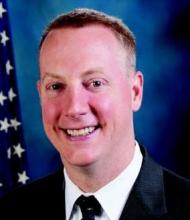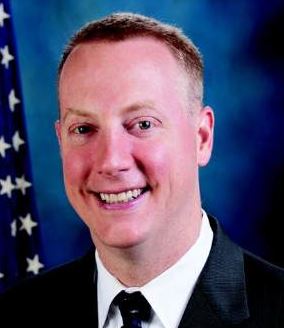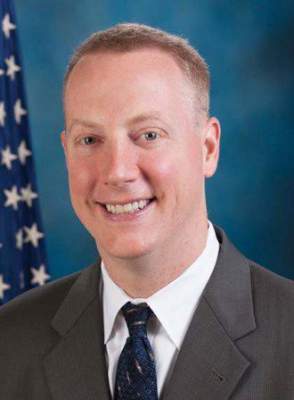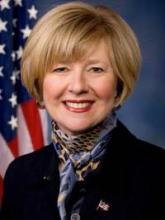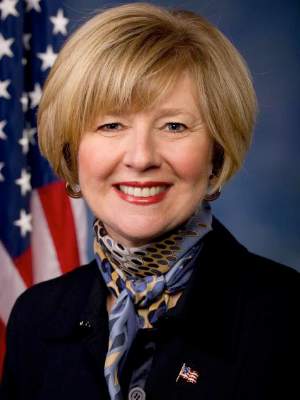User login
Evidence-based medicine the future of health care, experts say
WASHINGTON – The widespread use of evidence-based pathways will be a good thing for health care, according to Ascension Health senior vice president Dr. Michael Schatzlein.
Speaking at the Hospital of Tomorrow meeting, Dr. Schatzlein said that the more “medicine can be protocolized, the safer we’ll be and the healthier we’ll be.”
Some providers have feared that a by-product of evidence-based medicine would be so-called “cookbook medicine,” but Dr. Schatzlein noted that, “in truth, about 85% of the patients manged by every doctor with a relatively narrowly defined condition can be managed the same way and should be on a pathway.”
As more evidence is gathered, the role of the doctor will transform, Dr. Schatzlein said, to a health care provider focused more on the medical outliers, leaving “very little room for physician style.”
“The brilliance of the doctor comes from identifying … who is sliding off the pathway and to whom the pathway doesn’t apply, and applying all your expertise in those circumstances and letting the rest come through on protocol,” he added.
Speaking on a panel discussing value-based care, Dr. Schatzlein also suggested that it might take some time for the public to truly embrace value-based care.
“We are pushing something the public doesn’t want,” he said. “They want access. They want to pick their provider.… Americans have been trained [to] overconsume care and demand more care than they need.” He said that if there was a move to pure value-based medicine, with the appropriate incentives, “the populace would revolt.”
But the quality and quantity of data still remain an issue, and a change in mindset must occur in order to share more than the bare minimum HIPAA-compliant data, Dr. Schatzlein said at the meeting, which was sponsored by U.S News and World Report.
Dr. Jim Frankfort, chief medical officer and vice president of clinical informatics at IMS Health, suggested that most of the low-hanging fruit in the quality improvement and cost reduction space has already been picked, and at this point “no matter how big you are, you don’t have enough data for the subtle improvements in quality and cost that we’re left with. Even if you had the data, how many of your institutions have the clinicians with the expertise to know how to do continuous process improvement? And then there’s the matter of who’s going to pay for it.”
He predicted that an unprecedented level of collaboration between competitive hospitals and health systems will be necessary to achieve the full gains of value-based care.
“I think hospitals are going to contribute their data so collectively we can amass the scale necessary to address the subtle issues that impact cost and quality,” Dr. Frankfort said, noting that the contributions must go beyond HIPAA-compliant data. “Simple changes in data can render it completely useless for a whole swath of problems you want to address. The changes we need to make in data sets for HIPAA compliance really render it useless for a lot of the stuff we are going to need.”
WASHINGTON – The widespread use of evidence-based pathways will be a good thing for health care, according to Ascension Health senior vice president Dr. Michael Schatzlein.
Speaking at the Hospital of Tomorrow meeting, Dr. Schatzlein said that the more “medicine can be protocolized, the safer we’ll be and the healthier we’ll be.”
Some providers have feared that a by-product of evidence-based medicine would be so-called “cookbook medicine,” but Dr. Schatzlein noted that, “in truth, about 85% of the patients manged by every doctor with a relatively narrowly defined condition can be managed the same way and should be on a pathway.”
As more evidence is gathered, the role of the doctor will transform, Dr. Schatzlein said, to a health care provider focused more on the medical outliers, leaving “very little room for physician style.”
“The brilliance of the doctor comes from identifying … who is sliding off the pathway and to whom the pathway doesn’t apply, and applying all your expertise in those circumstances and letting the rest come through on protocol,” he added.
Speaking on a panel discussing value-based care, Dr. Schatzlein also suggested that it might take some time for the public to truly embrace value-based care.
“We are pushing something the public doesn’t want,” he said. “They want access. They want to pick their provider.… Americans have been trained [to] overconsume care and demand more care than they need.” He said that if there was a move to pure value-based medicine, with the appropriate incentives, “the populace would revolt.”
But the quality and quantity of data still remain an issue, and a change in mindset must occur in order to share more than the bare minimum HIPAA-compliant data, Dr. Schatzlein said at the meeting, which was sponsored by U.S News and World Report.
Dr. Jim Frankfort, chief medical officer and vice president of clinical informatics at IMS Health, suggested that most of the low-hanging fruit in the quality improvement and cost reduction space has already been picked, and at this point “no matter how big you are, you don’t have enough data for the subtle improvements in quality and cost that we’re left with. Even if you had the data, how many of your institutions have the clinicians with the expertise to know how to do continuous process improvement? And then there’s the matter of who’s going to pay for it.”
He predicted that an unprecedented level of collaboration between competitive hospitals and health systems will be necessary to achieve the full gains of value-based care.
“I think hospitals are going to contribute their data so collectively we can amass the scale necessary to address the subtle issues that impact cost and quality,” Dr. Frankfort said, noting that the contributions must go beyond HIPAA-compliant data. “Simple changes in data can render it completely useless for a whole swath of problems you want to address. The changes we need to make in data sets for HIPAA compliance really render it useless for a lot of the stuff we are going to need.”
WASHINGTON – The widespread use of evidence-based pathways will be a good thing for health care, according to Ascension Health senior vice president Dr. Michael Schatzlein.
Speaking at the Hospital of Tomorrow meeting, Dr. Schatzlein said that the more “medicine can be protocolized, the safer we’ll be and the healthier we’ll be.”
Some providers have feared that a by-product of evidence-based medicine would be so-called “cookbook medicine,” but Dr. Schatzlein noted that, “in truth, about 85% of the patients manged by every doctor with a relatively narrowly defined condition can be managed the same way and should be on a pathway.”
As more evidence is gathered, the role of the doctor will transform, Dr. Schatzlein said, to a health care provider focused more on the medical outliers, leaving “very little room for physician style.”
“The brilliance of the doctor comes from identifying … who is sliding off the pathway and to whom the pathway doesn’t apply, and applying all your expertise in those circumstances and letting the rest come through on protocol,” he added.
Speaking on a panel discussing value-based care, Dr. Schatzlein also suggested that it might take some time for the public to truly embrace value-based care.
“We are pushing something the public doesn’t want,” he said. “They want access. They want to pick their provider.… Americans have been trained [to] overconsume care and demand more care than they need.” He said that if there was a move to pure value-based medicine, with the appropriate incentives, “the populace would revolt.”
But the quality and quantity of data still remain an issue, and a change in mindset must occur in order to share more than the bare minimum HIPAA-compliant data, Dr. Schatzlein said at the meeting, which was sponsored by U.S News and World Report.
Dr. Jim Frankfort, chief medical officer and vice president of clinical informatics at IMS Health, suggested that most of the low-hanging fruit in the quality improvement and cost reduction space has already been picked, and at this point “no matter how big you are, you don’t have enough data for the subtle improvements in quality and cost that we’re left with. Even if you had the data, how many of your institutions have the clinicians with the expertise to know how to do continuous process improvement? And then there’s the matter of who’s going to pay for it.”
He predicted that an unprecedented level of collaboration between competitive hospitals and health systems will be necessary to achieve the full gains of value-based care.
“I think hospitals are going to contribute their data so collectively we can amass the scale necessary to address the subtle issues that impact cost and quality,” Dr. Frankfort said, noting that the contributions must go beyond HIPAA-compliant data. “Simple changes in data can render it completely useless for a whole swath of problems you want to address. The changes we need to make in data sets for HIPAA compliance really render it useless for a lot of the stuff we are going to need.”
AT THE HOSPITAL OF TOMORROW MEETING
CMS delays Stage 3 meaningful use
Doctors will have 1 more year – until Jan. 1, 2018 – to comply with Stage 3 meaningful use requirements for electronic health records (EHRs), the Centers for Medicare & Medicaid Services announced.
In its long-awaited final rule, released Oct. 6, CMS also announced simplifications to the program designed to align meaningful use with other incentive programs and shift the overall focus of the programs to make them tools for improving overall health.
The announced changes “will ease the reporting burden for providers, increase simplicity and flexibility, support interoperability and information exchange, and improve patient outcomes,” CMS Acting Principal Deputy Administrator and Chief Medical Officer Patrick Conway noted during an Oct. 6 conference call with the media.
AGA supports this delay and modifications to Stage 2, and signed a letter (http://ow.ly/TCwS9), along with all of organized medicine, seeking this change.
Dr. Conway noted that the final rule reduces the number of objectives from about 20 to 8 to allow doctors to find the measures that are most relevant to their practice. Measures also are better aligned, so that a single measure can allow providers to earn credit across multiple incentive programs.
CMS also explained in a separate fact sheet that it was removing many of the “check box” process measures and enhancing the focus on aspects of patient care, such as clinical decision support, e-prescribing, and information exchange.
The agency also finalized a 90-day reporting period in 2015 for all providers currently active in the meaningful use program. Given that the rule was finalized with fewer than 90 days left in the year, Dr. Conway provided additional clarity regarding the flexibility physicians will have to meet those requirements.
If doctors were using an electronic health record on Oct. 1, 2015, “they actually will not report until the end of February, and if we need to extend that time frame, we would look at that at the end of February 2016,” he said. “So, they still have almost 5 months before the reporting actually occurs.”
Dr. Conway added that even if a provider launched an EHR system after Oct. 1, “the thresholds for the program are not 100%. So, even if they were to deploy it tomorrow [and] use it successfully through the end of the year, they could then report that performance in 2016 and avoid a penalty.”
Providers also can use the exemption process if there have been implementation issues, which CMS reviews on a case-by-case basis.
Stage 2 concerns linger
There was concern that the changes did not go far enough, particularly as they relate to modifications of Stage 2 meaningful use.
“Many of the requirements for Stage 2 proved unattainable,” American College of Cardiology President Kim Allan Williams Sr. said in a statement. “Large numbers of providers either haven’t met them or, after trying and failing, have given up. That is why it is vital that CMS consider participation data from the current stage to see what is working and what isn’t before outlining an upcoming stage.”
By 2018, all providers will have to meet Stage 3 meaningful use requirements, because the earlier stages will no longer be available to help new entrants transition into the program. However, if a provider chooses to adopt the 2018 requirements a year early, they will have only a 90-day reporting requirement.
What about MACRA?
Even with the extended time line, CMS is drawing criticism for progressing with Stage 3.
“We still have some concerns about how the program is going,” Laura C. Wooster, vice president of public policy at the American Osteopathic Association, said in an interview.
One prime area of concern is the current meaningful use time line’s intersection with the start of the Medicare Access and CHIP Reauthorization Act of 2015 (MACRA) reforms, which will replace the Medicare Sustainable Growth Rate payment system, Ms. Wooster noted.
“Stage 3 begins voluntarily in 2017 and then is required for all physicians in 2018. MACRA begins in 2019, and electronic health record reporting will still be part of the Merit-Based Incentive Payment System.”
She expressed concern that physicians are going to have to make changes for Stage 3 meaningful use in 2018, only to have to make more changes to account for MACRA a year later.
The American Medical Association expressed similar concerns.
“The AMA recognizes that physicians continue to struggle with the meaningful use program,” AMA President Steven Stack said in a statement. “However, we hope the decision by CMS to leave Stage 3 open to additional comment will allow for further improvements in the program and promote technological innovation that supports patient care,” Dr. Stack added.
Given the changes that will come as a result of MACRA, CMS is taking comments on the final rule to help inform future policy on how it and MACRA will align.
[email protected]
Doctors will have 1 more year – until Jan. 1, 2018 – to comply with Stage 3 meaningful use requirements for electronic health records (EHRs), the Centers for Medicare & Medicaid Services announced.
In its long-awaited final rule, released Oct. 6, CMS also announced simplifications to the program designed to align meaningful use with other incentive programs and shift the overall focus of the programs to make them tools for improving overall health.
The announced changes “will ease the reporting burden for providers, increase simplicity and flexibility, support interoperability and information exchange, and improve patient outcomes,” CMS Acting Principal Deputy Administrator and Chief Medical Officer Patrick Conway noted during an Oct. 6 conference call with the media.
AGA supports this delay and modifications to Stage 2, and signed a letter (http://ow.ly/TCwS9), along with all of organized medicine, seeking this change.
Dr. Conway noted that the final rule reduces the number of objectives from about 20 to 8 to allow doctors to find the measures that are most relevant to their practice. Measures also are better aligned, so that a single measure can allow providers to earn credit across multiple incentive programs.
CMS also explained in a separate fact sheet that it was removing many of the “check box” process measures and enhancing the focus on aspects of patient care, such as clinical decision support, e-prescribing, and information exchange.
The agency also finalized a 90-day reporting period in 2015 for all providers currently active in the meaningful use program. Given that the rule was finalized with fewer than 90 days left in the year, Dr. Conway provided additional clarity regarding the flexibility physicians will have to meet those requirements.
If doctors were using an electronic health record on Oct. 1, 2015, “they actually will not report until the end of February, and if we need to extend that time frame, we would look at that at the end of February 2016,” he said. “So, they still have almost 5 months before the reporting actually occurs.”
Dr. Conway added that even if a provider launched an EHR system after Oct. 1, “the thresholds for the program are not 100%. So, even if they were to deploy it tomorrow [and] use it successfully through the end of the year, they could then report that performance in 2016 and avoid a penalty.”
Providers also can use the exemption process if there have been implementation issues, which CMS reviews on a case-by-case basis.
Stage 2 concerns linger
There was concern that the changes did not go far enough, particularly as they relate to modifications of Stage 2 meaningful use.
“Many of the requirements for Stage 2 proved unattainable,” American College of Cardiology President Kim Allan Williams Sr. said in a statement. “Large numbers of providers either haven’t met them or, after trying and failing, have given up. That is why it is vital that CMS consider participation data from the current stage to see what is working and what isn’t before outlining an upcoming stage.”
By 2018, all providers will have to meet Stage 3 meaningful use requirements, because the earlier stages will no longer be available to help new entrants transition into the program. However, if a provider chooses to adopt the 2018 requirements a year early, they will have only a 90-day reporting requirement.
What about MACRA?
Even with the extended time line, CMS is drawing criticism for progressing with Stage 3.
“We still have some concerns about how the program is going,” Laura C. Wooster, vice president of public policy at the American Osteopathic Association, said in an interview.
One prime area of concern is the current meaningful use time line’s intersection with the start of the Medicare Access and CHIP Reauthorization Act of 2015 (MACRA) reforms, which will replace the Medicare Sustainable Growth Rate payment system, Ms. Wooster noted.
“Stage 3 begins voluntarily in 2017 and then is required for all physicians in 2018. MACRA begins in 2019, and electronic health record reporting will still be part of the Merit-Based Incentive Payment System.”
She expressed concern that physicians are going to have to make changes for Stage 3 meaningful use in 2018, only to have to make more changes to account for MACRA a year later.
The American Medical Association expressed similar concerns.
“The AMA recognizes that physicians continue to struggle with the meaningful use program,” AMA President Steven Stack said in a statement. “However, we hope the decision by CMS to leave Stage 3 open to additional comment will allow for further improvements in the program and promote technological innovation that supports patient care,” Dr. Stack added.
Given the changes that will come as a result of MACRA, CMS is taking comments on the final rule to help inform future policy on how it and MACRA will align.
[email protected]
Doctors will have 1 more year – until Jan. 1, 2018 – to comply with Stage 3 meaningful use requirements for electronic health records (EHRs), the Centers for Medicare & Medicaid Services announced.
In its long-awaited final rule, released Oct. 6, CMS also announced simplifications to the program designed to align meaningful use with other incentive programs and shift the overall focus of the programs to make them tools for improving overall health.
The announced changes “will ease the reporting burden for providers, increase simplicity and flexibility, support interoperability and information exchange, and improve patient outcomes,” CMS Acting Principal Deputy Administrator and Chief Medical Officer Patrick Conway noted during an Oct. 6 conference call with the media.
AGA supports this delay and modifications to Stage 2, and signed a letter (http://ow.ly/TCwS9), along with all of organized medicine, seeking this change.
Dr. Conway noted that the final rule reduces the number of objectives from about 20 to 8 to allow doctors to find the measures that are most relevant to their practice. Measures also are better aligned, so that a single measure can allow providers to earn credit across multiple incentive programs.
CMS also explained in a separate fact sheet that it was removing many of the “check box” process measures and enhancing the focus on aspects of patient care, such as clinical decision support, e-prescribing, and information exchange.
The agency also finalized a 90-day reporting period in 2015 for all providers currently active in the meaningful use program. Given that the rule was finalized with fewer than 90 days left in the year, Dr. Conway provided additional clarity regarding the flexibility physicians will have to meet those requirements.
If doctors were using an electronic health record on Oct. 1, 2015, “they actually will not report until the end of February, and if we need to extend that time frame, we would look at that at the end of February 2016,” he said. “So, they still have almost 5 months before the reporting actually occurs.”
Dr. Conway added that even if a provider launched an EHR system after Oct. 1, “the thresholds for the program are not 100%. So, even if they were to deploy it tomorrow [and] use it successfully through the end of the year, they could then report that performance in 2016 and avoid a penalty.”
Providers also can use the exemption process if there have been implementation issues, which CMS reviews on a case-by-case basis.
Stage 2 concerns linger
There was concern that the changes did not go far enough, particularly as they relate to modifications of Stage 2 meaningful use.
“Many of the requirements for Stage 2 proved unattainable,” American College of Cardiology President Kim Allan Williams Sr. said in a statement. “Large numbers of providers either haven’t met them or, after trying and failing, have given up. That is why it is vital that CMS consider participation data from the current stage to see what is working and what isn’t before outlining an upcoming stage.”
By 2018, all providers will have to meet Stage 3 meaningful use requirements, because the earlier stages will no longer be available to help new entrants transition into the program. However, if a provider chooses to adopt the 2018 requirements a year early, they will have only a 90-day reporting requirement.
What about MACRA?
Even with the extended time line, CMS is drawing criticism for progressing with Stage 3.
“We still have some concerns about how the program is going,” Laura C. Wooster, vice president of public policy at the American Osteopathic Association, said in an interview.
One prime area of concern is the current meaningful use time line’s intersection with the start of the Medicare Access and CHIP Reauthorization Act of 2015 (MACRA) reforms, which will replace the Medicare Sustainable Growth Rate payment system, Ms. Wooster noted.
“Stage 3 begins voluntarily in 2017 and then is required for all physicians in 2018. MACRA begins in 2019, and electronic health record reporting will still be part of the Merit-Based Incentive Payment System.”
She expressed concern that physicians are going to have to make changes for Stage 3 meaningful use in 2018, only to have to make more changes to account for MACRA a year later.
The American Medical Association expressed similar concerns.
“The AMA recognizes that physicians continue to struggle with the meaningful use program,” AMA President Steven Stack said in a statement. “However, we hope the decision by CMS to leave Stage 3 open to additional comment will allow for further improvements in the program and promote technological innovation that supports patient care,” Dr. Stack added.
Given the changes that will come as a result of MACRA, CMS is taking comments on the final rule to help inform future policy on how it and MACRA will align.
[email protected]
Pediatricians Encouraged to More Actively Mitigate Food Insecurity
Physicians are being encouraged to do more to help promote food security, according to a new policy statement issued by the American Academy of Pediatrics.
The organization’s Council on Community Pediatrics’ Committee on Nutrition is recommending screening patients for food insecurity during scheduled health maintenance visits or sooner; becoming familiar with community resources, such as the Special Supplemental Nutrition Program for Women, Infants and Children (WIC), SNAP, school nutrition programs, local food pantries, summer and child care feeding programs, and other programs to refer those who may have food insecurity issues; and be aware of the factors that may increase food insecurity.
AAP’s policy was published Oct. 23 in Pediatrics (2015 Oct. 23 [doi: 10.1542/peds.2015-3301]).
Erin R. Hager, Ph.D., et al. designed a practical in-office two-item screening tool. Answering “yes” to either of the questions identified food insecurity with a sensitivity of 97% and a specificity of 83% (Pediatrics. 2010 Jul;126[1]:e26-e32). The two screening items are as follows:
1. Within the past 12 months, we worried whether our food would run out before we got money to buy more. (Yes or No)
2. Within the past 12 months, the food we bought just didn’t last and we didn’t have money to get more. (Yes or No)
The statement notes that in 2013, “17.5 million U.S. households, or 14.3% of all households and 21% of all children, met the U.S. Department of Agriculture definition of a food-insecure household, one in which access to adequate food is limited by a lack of money or other resources.” And while poverty is a key factor leading to food insecurity, it adds that food insecurity “is associated with many factors. ... Unemployment and underemployment are also strongly associated with food insecurity.” Families at risk include immigrants, those that are large, those headed by single women, those with less education, and those experiencing parental separation or divorce.
Children with food insecurity also “have poorer overall health and more hospitalizations than do children who live in food-secure households.” Additionally, food insecurity could be an indirect cause for obesity and is linked with lower cognitive indicators, dysregulated behavior, and emotional distress.
In the office, be aware of factors that may increase vulnerability of food-insecure populations to obesity, such as “lack of access to healthy and affordable foods, cost of healthy food (and the low cost of many unhealthy foods), media messaging that promotes nonnutritious foods and beverages, and the role of stress in decision-making related to food,” according to the statement.
On a national advocacy level, AAP also is calling for food insecurity, including screening tools and community resource guidelines, to be incorporated into medical school education; and for support for interdisciplinary research to better understand the relationship between stress, food insecurity, and adverse health consequences.
Physicians are being encouraged to do more to help promote food security, according to a new policy statement issued by the American Academy of Pediatrics.
The organization’s Council on Community Pediatrics’ Committee on Nutrition is recommending screening patients for food insecurity during scheduled health maintenance visits or sooner; becoming familiar with community resources, such as the Special Supplemental Nutrition Program for Women, Infants and Children (WIC), SNAP, school nutrition programs, local food pantries, summer and child care feeding programs, and other programs to refer those who may have food insecurity issues; and be aware of the factors that may increase food insecurity.
AAP’s policy was published Oct. 23 in Pediatrics (2015 Oct. 23 [doi: 10.1542/peds.2015-3301]).
Erin R. Hager, Ph.D., et al. designed a practical in-office two-item screening tool. Answering “yes” to either of the questions identified food insecurity with a sensitivity of 97% and a specificity of 83% (Pediatrics. 2010 Jul;126[1]:e26-e32). The two screening items are as follows:
1. Within the past 12 months, we worried whether our food would run out before we got money to buy more. (Yes or No)
2. Within the past 12 months, the food we bought just didn’t last and we didn’t have money to get more. (Yes or No)
The statement notes that in 2013, “17.5 million U.S. households, or 14.3% of all households and 21% of all children, met the U.S. Department of Agriculture definition of a food-insecure household, one in which access to adequate food is limited by a lack of money or other resources.” And while poverty is a key factor leading to food insecurity, it adds that food insecurity “is associated with many factors. ... Unemployment and underemployment are also strongly associated with food insecurity.” Families at risk include immigrants, those that are large, those headed by single women, those with less education, and those experiencing parental separation or divorce.
Children with food insecurity also “have poorer overall health and more hospitalizations than do children who live in food-secure households.” Additionally, food insecurity could be an indirect cause for obesity and is linked with lower cognitive indicators, dysregulated behavior, and emotional distress.
In the office, be aware of factors that may increase vulnerability of food-insecure populations to obesity, such as “lack of access to healthy and affordable foods, cost of healthy food (and the low cost of many unhealthy foods), media messaging that promotes nonnutritious foods and beverages, and the role of stress in decision-making related to food,” according to the statement.
On a national advocacy level, AAP also is calling for food insecurity, including screening tools and community resource guidelines, to be incorporated into medical school education; and for support for interdisciplinary research to better understand the relationship between stress, food insecurity, and adverse health consequences.
Physicians are being encouraged to do more to help promote food security, according to a new policy statement issued by the American Academy of Pediatrics.
The organization’s Council on Community Pediatrics’ Committee on Nutrition is recommending screening patients for food insecurity during scheduled health maintenance visits or sooner; becoming familiar with community resources, such as the Special Supplemental Nutrition Program for Women, Infants and Children (WIC), SNAP, school nutrition programs, local food pantries, summer and child care feeding programs, and other programs to refer those who may have food insecurity issues; and be aware of the factors that may increase food insecurity.
AAP’s policy was published Oct. 23 in Pediatrics (2015 Oct. 23 [doi: 10.1542/peds.2015-3301]).
Erin R. Hager, Ph.D., et al. designed a practical in-office two-item screening tool. Answering “yes” to either of the questions identified food insecurity with a sensitivity of 97% and a specificity of 83% (Pediatrics. 2010 Jul;126[1]:e26-e32). The two screening items are as follows:
1. Within the past 12 months, we worried whether our food would run out before we got money to buy more. (Yes or No)
2. Within the past 12 months, the food we bought just didn’t last and we didn’t have money to get more. (Yes or No)
The statement notes that in 2013, “17.5 million U.S. households, or 14.3% of all households and 21% of all children, met the U.S. Department of Agriculture definition of a food-insecure household, one in which access to adequate food is limited by a lack of money or other resources.” And while poverty is a key factor leading to food insecurity, it adds that food insecurity “is associated with many factors. ... Unemployment and underemployment are also strongly associated with food insecurity.” Families at risk include immigrants, those that are large, those headed by single women, those with less education, and those experiencing parental separation or divorce.
Children with food insecurity also “have poorer overall health and more hospitalizations than do children who live in food-secure households.” Additionally, food insecurity could be an indirect cause for obesity and is linked with lower cognitive indicators, dysregulated behavior, and emotional distress.
In the office, be aware of factors that may increase vulnerability of food-insecure populations to obesity, such as “lack of access to healthy and affordable foods, cost of healthy food (and the low cost of many unhealthy foods), media messaging that promotes nonnutritious foods and beverages, and the role of stress in decision-making related to food,” according to the statement.
On a national advocacy level, AAP also is calling for food insecurity, including screening tools and community resource guidelines, to be incorporated into medical school education; and for support for interdisciplinary research to better understand the relationship between stress, food insecurity, and adverse health consequences.
FROM PEDIATRICS
Pediatricians encouraged to more actively mitigate food insecurity
Physicians are being encouraged to do more to help promote food security, according to a new policy statement issued by the American Academy of Pediatrics.
The organization’s Council on Community Pediatrics’ Committee on Nutrition is recommending screening patients for food insecurity during scheduled health maintenance visits or sooner; becoming familiar with community resources, such as the Special Supplemental Nutrition Program for Women, Infants and Children (WIC), SNAP, school nutrition programs, local food pantries, summer and child care feeding programs, and other programs to refer those who may have food insecurity issues; and be aware of the factors that may increase food insecurity.
AAP’s policy was published Oct. 23 in Pediatrics (2015 Oct. 23 [doi: 10.1542/peds.2015-3301]).
Erin R. Hager, Ph.D., et al. designed a practical in-office two-item screening tool. Answering “yes” to either of the questions identified food insecurity with a sensitivity of 97% and a specificity of 83% (Pediatrics. 2010 Jul;126[1]:e26-e32). The two screening items are as follows:
1. Within the past 12 months, we worried whether our food would run out before we got money to buy more. (Yes or No)
2. Within the past 12 months, the food we bought just didn’t last and we didn’t have money to get more. (Yes or No)
The statement notes that in 2013, “17.5 million U.S. households, or 14.3% of all households and 21% of all children, met the U.S. Department of Agriculture definition of a food-insecure household, one in which access to adequate food is limited by a lack of money or other resources.” And while poverty is a key factor leading to food insecurity, it adds that food insecurity “is associated with many factors. ... Unemployment and underemployment are also strongly associated with food insecurity.” Families at risk include immigrants, those that are large, those headed by single women, those with less education, and those experiencing parental separation or divorce.
Children with food insecurity also “have poorer overall health and more hospitalizations than do children who live in food-secure households.” Additionally, food insecurity could be an indirect cause for obesity and is linked with lower cognitive indicators, dysregulated behavior, and emotional distress.
In the office, be aware of factors that may increase vulnerability of food-insecure populations to obesity, such as “lack of access to healthy and affordable foods, cost of healthy food (and the low cost of many unhealthy foods), media messaging that promotes nonnutritious foods and beverages, and the role of stress in decision-making related to food,” according to the statement.
On a national advocacy level, AAP also is calling for food insecurity, including screening tools and community resource guidelines, to be incorporated into medical school education; and for support for interdisciplinary research to better understand the relationship between stress, food insecurity, and adverse health consequences.
Physicians are being encouraged to do more to help promote food security, according to a new policy statement issued by the American Academy of Pediatrics.
The organization’s Council on Community Pediatrics’ Committee on Nutrition is recommending screening patients for food insecurity during scheduled health maintenance visits or sooner; becoming familiar with community resources, such as the Special Supplemental Nutrition Program for Women, Infants and Children (WIC), SNAP, school nutrition programs, local food pantries, summer and child care feeding programs, and other programs to refer those who may have food insecurity issues; and be aware of the factors that may increase food insecurity.
AAP’s policy was published Oct. 23 in Pediatrics (2015 Oct. 23 [doi: 10.1542/peds.2015-3301]).
Erin R. Hager, Ph.D., et al. designed a practical in-office two-item screening tool. Answering “yes” to either of the questions identified food insecurity with a sensitivity of 97% and a specificity of 83% (Pediatrics. 2010 Jul;126[1]:e26-e32). The two screening items are as follows:
1. Within the past 12 months, we worried whether our food would run out before we got money to buy more. (Yes or No)
2. Within the past 12 months, the food we bought just didn’t last and we didn’t have money to get more. (Yes or No)
The statement notes that in 2013, “17.5 million U.S. households, or 14.3% of all households and 21% of all children, met the U.S. Department of Agriculture definition of a food-insecure household, one in which access to adequate food is limited by a lack of money or other resources.” And while poverty is a key factor leading to food insecurity, it adds that food insecurity “is associated with many factors. ... Unemployment and underemployment are also strongly associated with food insecurity.” Families at risk include immigrants, those that are large, those headed by single women, those with less education, and those experiencing parental separation or divorce.
Children with food insecurity also “have poorer overall health and more hospitalizations than do children who live in food-secure households.” Additionally, food insecurity could be an indirect cause for obesity and is linked with lower cognitive indicators, dysregulated behavior, and emotional distress.
In the office, be aware of factors that may increase vulnerability of food-insecure populations to obesity, such as “lack of access to healthy and affordable foods, cost of healthy food (and the low cost of many unhealthy foods), media messaging that promotes nonnutritious foods and beverages, and the role of stress in decision-making related to food,” according to the statement.
On a national advocacy level, AAP also is calling for food insecurity, including screening tools and community resource guidelines, to be incorporated into medical school education; and for support for interdisciplinary research to better understand the relationship between stress, food insecurity, and adverse health consequences.
Physicians are being encouraged to do more to help promote food security, according to a new policy statement issued by the American Academy of Pediatrics.
The organization’s Council on Community Pediatrics’ Committee on Nutrition is recommending screening patients for food insecurity during scheduled health maintenance visits or sooner; becoming familiar with community resources, such as the Special Supplemental Nutrition Program for Women, Infants and Children (WIC), SNAP, school nutrition programs, local food pantries, summer and child care feeding programs, and other programs to refer those who may have food insecurity issues; and be aware of the factors that may increase food insecurity.
AAP’s policy was published Oct. 23 in Pediatrics (2015 Oct. 23 [doi: 10.1542/peds.2015-3301]).
Erin R. Hager, Ph.D., et al. designed a practical in-office two-item screening tool. Answering “yes” to either of the questions identified food insecurity with a sensitivity of 97% and a specificity of 83% (Pediatrics. 2010 Jul;126[1]:e26-e32). The two screening items are as follows:
1. Within the past 12 months, we worried whether our food would run out before we got money to buy more. (Yes or No)
2. Within the past 12 months, the food we bought just didn’t last and we didn’t have money to get more. (Yes or No)
The statement notes that in 2013, “17.5 million U.S. households, or 14.3% of all households and 21% of all children, met the U.S. Department of Agriculture definition of a food-insecure household, one in which access to adequate food is limited by a lack of money or other resources.” And while poverty is a key factor leading to food insecurity, it adds that food insecurity “is associated with many factors. ... Unemployment and underemployment are also strongly associated with food insecurity.” Families at risk include immigrants, those that are large, those headed by single women, those with less education, and those experiencing parental separation or divorce.
Children with food insecurity also “have poorer overall health and more hospitalizations than do children who live in food-secure households.” Additionally, food insecurity could be an indirect cause for obesity and is linked with lower cognitive indicators, dysregulated behavior, and emotional distress.
In the office, be aware of factors that may increase vulnerability of food-insecure populations to obesity, such as “lack of access to healthy and affordable foods, cost of healthy food (and the low cost of many unhealthy foods), media messaging that promotes nonnutritious foods and beverages, and the role of stress in decision-making related to food,” according to the statement.
On a national advocacy level, AAP also is calling for food insecurity, including screening tools and community resource guidelines, to be incorporated into medical school education; and for support for interdisciplinary research to better understand the relationship between stress, food insecurity, and adverse health consequences.
FROM PEDIATRICS
PQRS informal review period opens; closes Nov. 9
The deadline to conduct an informal review of your 2016 value modifier under the Physician Quality Reporting System (PQRS) is Nov. 9, 2015.
The Centers for Medicare & Medicaid Services announced the preview of 2014 annual Quality and Resource Use Reports for all group and solo providers nationwide, accessible by taxpayer identification number. Reports also are available for participants in the Medicare Shared Savings Program, the Pioneer ACO Model, or the Comprehensive Primary Care Initiative in 2014.
The reports show 2014 performance levels on quality and cost measures that will be used to calculate the 2016 value modifier. For groups of 10 or more, the report also will show the affect of the modifier on their physician fee schedule payments. For smaller groups and solo providers, the report is informational only and will not affect payments.
The report can be accessed on the CMS Enterprise Portal. The agency’s website also provides information on how to access the report.
The deadline to conduct an informal review of your 2016 value modifier under the Physician Quality Reporting System (PQRS) is Nov. 9, 2015.
The Centers for Medicare & Medicaid Services announced the preview of 2014 annual Quality and Resource Use Reports for all group and solo providers nationwide, accessible by taxpayer identification number. Reports also are available for participants in the Medicare Shared Savings Program, the Pioneer ACO Model, or the Comprehensive Primary Care Initiative in 2014.
The reports show 2014 performance levels on quality and cost measures that will be used to calculate the 2016 value modifier. For groups of 10 or more, the report also will show the affect of the modifier on their physician fee schedule payments. For smaller groups and solo providers, the report is informational only and will not affect payments.
The report can be accessed on the CMS Enterprise Portal. The agency’s website also provides information on how to access the report.
The deadline to conduct an informal review of your 2016 value modifier under the Physician Quality Reporting System (PQRS) is Nov. 9, 2015.
The Centers for Medicare & Medicaid Services announced the preview of 2014 annual Quality and Resource Use Reports for all group and solo providers nationwide, accessible by taxpayer identification number. Reports also are available for participants in the Medicare Shared Savings Program, the Pioneer ACO Model, or the Comprehensive Primary Care Initiative in 2014.
The reports show 2014 performance levels on quality and cost measures that will be used to calculate the 2016 value modifier. For groups of 10 or more, the report also will show the affect of the modifier on their physician fee schedule payments. For smaller groups and solo providers, the report is informational only and will not affect payments.
The report can be accessed on the CMS Enterprise Portal. The agency’s website also provides information on how to access the report.
Survey: Medicaid pay holds steady in states
Medicaid payment rates are holding firm, according to a survey of Medicaid directors from each state and the District of Columbia released Oct. 15 by the Kaiser Family Foundation.
“No states are now making across-the-board budget-driven cuts to Medicaid provider rates in fiscal 2016, something which we quite commonly saw only a few years ago during the economic downturn,” Vern Smith, Ph.D., managing principal of Health Management Associates, said during a press briefing on the survey.
Dr. Smith noted that the rate increases and decreases that are occurring are “routine and targeted in nature.”
State Medicaid programs are increasing benefits as well. “Last year, just one state limited their benefit,” and it was utilization controls applied to those who qualified for expanded Medicaid access, Dr. Smith said. For fiscal 2016, five states reported benefit restrictions. “On the other hand, over half of the states, a total of 28, expanded benefits in some way, with 24 states expanding or enhancing benefit offerings in 2015, and 18 states adopting benefit expansions/enhancements for fiscal 2016.
“The most common benefit expansion … was for behavioral health services,” Dr. Smith said. “The second most common was for long-term care service.” Other areas that had expansion of benefits were in dental services and telemedicine.
Concerns for state Medicaid programs also were identified in the survey, specifically regarding Medicaid expansion under the Affordable Care Act and cost control.
“The focus on ensuring the greatest possible value for state tax payers is always a top priority,” Dr. Smith said. “Many directors in this area specifically singled out their priority on controlling the escalating cost of specialty drugs.”
Other priorities included delivery system and payment reform initiatives and a greater focus on the social determinants of health and population health, two terms Dr. Smith described as being something new in the vocabulary of Medicaid.
“State Medicaid programs are focused on performance, value, and improving health in a way never seen before in the 50-year history of the program,” he said.
The stability of benefits and payment rates comes as Medicaid is seeing its greatest increases in enrollment and state government spending, primarily driven by the ACA. Currently, 30 states and the District of Columbia have expanded their Medicaid eligibility.
Medicaid payment rates are holding firm, according to a survey of Medicaid directors from each state and the District of Columbia released Oct. 15 by the Kaiser Family Foundation.
“No states are now making across-the-board budget-driven cuts to Medicaid provider rates in fiscal 2016, something which we quite commonly saw only a few years ago during the economic downturn,” Vern Smith, Ph.D., managing principal of Health Management Associates, said during a press briefing on the survey.
Dr. Smith noted that the rate increases and decreases that are occurring are “routine and targeted in nature.”
State Medicaid programs are increasing benefits as well. “Last year, just one state limited their benefit,” and it was utilization controls applied to those who qualified for expanded Medicaid access, Dr. Smith said. For fiscal 2016, five states reported benefit restrictions. “On the other hand, over half of the states, a total of 28, expanded benefits in some way, with 24 states expanding or enhancing benefit offerings in 2015, and 18 states adopting benefit expansions/enhancements for fiscal 2016.
“The most common benefit expansion … was for behavioral health services,” Dr. Smith said. “The second most common was for long-term care service.” Other areas that had expansion of benefits were in dental services and telemedicine.
Concerns for state Medicaid programs also were identified in the survey, specifically regarding Medicaid expansion under the Affordable Care Act and cost control.
“The focus on ensuring the greatest possible value for state tax payers is always a top priority,” Dr. Smith said. “Many directors in this area specifically singled out their priority on controlling the escalating cost of specialty drugs.”
Other priorities included delivery system and payment reform initiatives and a greater focus on the social determinants of health and population health, two terms Dr. Smith described as being something new in the vocabulary of Medicaid.
“State Medicaid programs are focused on performance, value, and improving health in a way never seen before in the 50-year history of the program,” he said.
The stability of benefits and payment rates comes as Medicaid is seeing its greatest increases in enrollment and state government spending, primarily driven by the ACA. Currently, 30 states and the District of Columbia have expanded their Medicaid eligibility.
Medicaid payment rates are holding firm, according to a survey of Medicaid directors from each state and the District of Columbia released Oct. 15 by the Kaiser Family Foundation.
“No states are now making across-the-board budget-driven cuts to Medicaid provider rates in fiscal 2016, something which we quite commonly saw only a few years ago during the economic downturn,” Vern Smith, Ph.D., managing principal of Health Management Associates, said during a press briefing on the survey.
Dr. Smith noted that the rate increases and decreases that are occurring are “routine and targeted in nature.”
State Medicaid programs are increasing benefits as well. “Last year, just one state limited their benefit,” and it was utilization controls applied to those who qualified for expanded Medicaid access, Dr. Smith said. For fiscal 2016, five states reported benefit restrictions. “On the other hand, over half of the states, a total of 28, expanded benefits in some way, with 24 states expanding or enhancing benefit offerings in 2015, and 18 states adopting benefit expansions/enhancements for fiscal 2016.
“The most common benefit expansion … was for behavioral health services,” Dr. Smith said. “The second most common was for long-term care service.” Other areas that had expansion of benefits were in dental services and telemedicine.
Concerns for state Medicaid programs also were identified in the survey, specifically regarding Medicaid expansion under the Affordable Care Act and cost control.
“The focus on ensuring the greatest possible value for state tax payers is always a top priority,” Dr. Smith said. “Many directors in this area specifically singled out their priority on controlling the escalating cost of specialty drugs.”
Other priorities included delivery system and payment reform initiatives and a greater focus on the social determinants of health and population health, two terms Dr. Smith described as being something new in the vocabulary of Medicaid.
“State Medicaid programs are focused on performance, value, and improving health in a way never seen before in the 50-year history of the program,” he said.
The stability of benefits and payment rates comes as Medicaid is seeing its greatest increases in enrollment and state government spending, primarily driven by the ACA. Currently, 30 states and the District of Columbia have expanded their Medicaid eligibility.
Planned Parenthood won’t take money for fetal tissue donation
In an effort to deflect the controversy surrounding its practices around fetal tissue donation, Planned Parenthood announced it will no longer accept reimbursement for the collection of fetal tissue from abortions.
“In order to completely debunk the disingenuous argument that our opponents have been using – and to reveal the true political purpose of these attacks – our Federation has decided, going forward, that any Planned Parenthood health center that is involved in donating tissue after an abortion for medical research will follow the model already in place at one of our two affiliates currently facilitating donations for fetal tissue research,” Planned Parenthood Federation of America President Cecile Richards said in an Oct. 13 letter to the National Institutes of Health. “That affiliate accepts no reimbursement for its reasonable expenses – even though reimbursement is fully permitted” under federal law.
Planned Parenthood has been under fire for months after undercover videos released by the Center for Medical Progress showed Planned Parenthood employees discussing the collection of fetal tissue from abortions. The Center for Medical Progress has charged that Planned Parenthood is illegally profitting from fetal tissue collection, an allegation that Planned Parenthood has disputed.
The videos have prompted investigations in Congress and a few votes in the House to defund Planned Parenthood, though defunding attempts in the Senate have proven unsuccessful.
“When the attacks in Washington and in states continue, as we unfortunately expect they will, let it be clear once and for all that they have nothing to do with concern over fetal tissue donation and everything to do with banning abortion in the U.S.,” Ms. Richards said in a separate statement.
Rep. Marsha Blackburn (R-Tenn.), vice chair of the House Energy and Commerce Commmittee, said she welcomed the policy change but indicated that the investigations would continue.
“I’m glad to see Planned Parenthood is finally recognizing the need to end this disgusting practice. It’s about time,” Rep. Blackburn said in a statement. “However, there are still many questions yet to be answered surrounding Planned Parenthood’s business practices and relationships with the procurement organizations. This is exactly why the House is investigating abortion practices and how we can better protect life.”
In an effort to deflect the controversy surrounding its practices around fetal tissue donation, Planned Parenthood announced it will no longer accept reimbursement for the collection of fetal tissue from abortions.
“In order to completely debunk the disingenuous argument that our opponents have been using – and to reveal the true political purpose of these attacks – our Federation has decided, going forward, that any Planned Parenthood health center that is involved in donating tissue after an abortion for medical research will follow the model already in place at one of our two affiliates currently facilitating donations for fetal tissue research,” Planned Parenthood Federation of America President Cecile Richards said in an Oct. 13 letter to the National Institutes of Health. “That affiliate accepts no reimbursement for its reasonable expenses – even though reimbursement is fully permitted” under federal law.
Planned Parenthood has been under fire for months after undercover videos released by the Center for Medical Progress showed Planned Parenthood employees discussing the collection of fetal tissue from abortions. The Center for Medical Progress has charged that Planned Parenthood is illegally profitting from fetal tissue collection, an allegation that Planned Parenthood has disputed.
The videos have prompted investigations in Congress and a few votes in the House to defund Planned Parenthood, though defunding attempts in the Senate have proven unsuccessful.
“When the attacks in Washington and in states continue, as we unfortunately expect they will, let it be clear once and for all that they have nothing to do with concern over fetal tissue donation and everything to do with banning abortion in the U.S.,” Ms. Richards said in a separate statement.
Rep. Marsha Blackburn (R-Tenn.), vice chair of the House Energy and Commerce Commmittee, said she welcomed the policy change but indicated that the investigations would continue.
“I’m glad to see Planned Parenthood is finally recognizing the need to end this disgusting practice. It’s about time,” Rep. Blackburn said in a statement. “However, there are still many questions yet to be answered surrounding Planned Parenthood’s business practices and relationships with the procurement organizations. This is exactly why the House is investigating abortion practices and how we can better protect life.”
In an effort to deflect the controversy surrounding its practices around fetal tissue donation, Planned Parenthood announced it will no longer accept reimbursement for the collection of fetal tissue from abortions.
“In order to completely debunk the disingenuous argument that our opponents have been using – and to reveal the true political purpose of these attacks – our Federation has decided, going forward, that any Planned Parenthood health center that is involved in donating tissue after an abortion for medical research will follow the model already in place at one of our two affiliates currently facilitating donations for fetal tissue research,” Planned Parenthood Federation of America President Cecile Richards said in an Oct. 13 letter to the National Institutes of Health. “That affiliate accepts no reimbursement for its reasonable expenses – even though reimbursement is fully permitted” under federal law.
Planned Parenthood has been under fire for months after undercover videos released by the Center for Medical Progress showed Planned Parenthood employees discussing the collection of fetal tissue from abortions. The Center for Medical Progress has charged that Planned Parenthood is illegally profitting from fetal tissue collection, an allegation that Planned Parenthood has disputed.
The videos have prompted investigations in Congress and a few votes in the House to defund Planned Parenthood, though defunding attempts in the Senate have proven unsuccessful.
“When the attacks in Washington and in states continue, as we unfortunately expect they will, let it be clear once and for all that they have nothing to do with concern over fetal tissue donation and everything to do with banning abortion in the U.S.,” Ms. Richards said in a separate statement.
Rep. Marsha Blackburn (R-Tenn.), vice chair of the House Energy and Commerce Commmittee, said she welcomed the policy change but indicated that the investigations would continue.
“I’m glad to see Planned Parenthood is finally recognizing the need to end this disgusting practice. It’s about time,” Rep. Blackburn said in a statement. “However, there are still many questions yet to be answered surrounding Planned Parenthood’s business practices and relationships with the procurement organizations. This is exactly why the House is investigating abortion practices and how we can better protect life.”
CMS delays Stage 3 meaningful use until 2018, simplifies program
Doctors will have 1 more year – until Jan. 1, 2018 – to comply with Stage 3 meaningful use requirements for electronic health records (EHRs), the Centers for Medicare & Medicaid Services announced.
In its long-awaited final rule, released Oct. 6, CMS also announced simplifications to the program designed to align meaningful use with other incentive programs and shift the overall focus of the programs to make them tools for improving overall health.
The announced changes “will ease the reporting burden for providers, increase simplicity and flexibility, support interoperability and information exchange, and improve patient outcomes,” CMS Acting Principal Deputy Administrator and Chief Medical Officer Patrick Conway noted during an Oct. 6 conference call with the media.
Dr. Conway noted that the final rule reduces the number of objectives from about 20 to 8 to allow doctors to find the measures that are most relevant to their practice. Measures also are better aligned, so that a single measure can allow providers to earn credit across multiple incentive programs.
CMS also explained in a separate fact sheet that it was removing many of the “check box” process measures and enhancing the focus on aspects of patient care, such as clinical decision support, e-prescribing, and information exchange.
The agency also finalized a 90-day reporting period in 2015 for all providers currently active in the meaningful use program. Given that the rule was finalized with fewer than 90 days left in the year, Dr. Conway provided additional clarity regarding the flexibility physicians will have to meet those requirements.
If doctors were using an electronic health record on Oct. 1, 2015, “they actually will not report until the end of February, and if we need to extend that time frame, we would look at that at the end of February 2016,” he said. “So, they still have almost 5 months before the reporting actually occurs.”
Dr. Conway added that even if a provider launched an EHR system after Oct. 1, “the thresholds for the program are not 100%. So, even if they were to deploy it tomorrow [and] use it successfully through the end of the year, they could then report that performance in 2016 and avoid a penalty.”
Providers also can use the exemption process if there have been implementation issues, which CMS reviews on a case-by-case basis.
Stage 2 concerns linger
There was concern that the changes did not go far enough, particularly as they relate to modifications of Stage 2 meaningful use.
“Many of the requirements for Stage 2 proved unattainable,” American College of Cardiology President Kim Allan Williams Sr. said in a statement. “Large numbers of providers either haven’t met them or, after trying and failing, have given up. That is why it is vital that CMS consider participation data from the current stage to see what is working and what isn’t before outlining an upcoming stage.”
By 2018, all providers will have to meet Stage 3 meaningful use requirements, because the earlier stages will no longer be available to help new entrants transition into the program. However, if a provider chooses to adopt the 2018 requirements a year early, they will have only a 90-day reporting requirement.
What about MACRA?
Even with the extended time line, CMS is drawing criticism for progressing with Stage 3.
“We still have some concerns about how the program is going,” Ms. Laura C. Wooster, vice president of public policy at the American Osteopathic Association, said in an interview.
One prime area of concern is the current meaningful use time line’s intersection with the start of the Medicare Access and CHIP Reauthorization Act of 2015 (MACRA) reforms, which will replace the Medicare Sustainable Growth Rate payment system, Ms. Wooster noted.
“Stage 3 begins voluntarily in 2017 and then is required for all physicians in 2018. MACRA begins in 2019, and electronic health record reporting will still be part of the Merit-Based Incentive Payment System.”
She expressed concern that physicians are going to have to make changes for Stage 3 meaningful use in 2018, only to have to make more changes to account for MACRA a year later.
The American Medical Association expressed similar concerns.
“The AMA recognizes that physicians continue to struggle with the meaningful use program,” AMA President Steven Stack said in a statement. “However, we hope the decision by CMS to leave Stage 3 open to additional comment will allow for further improvements in the program and promote technological innovation that supports patient care,” Dr. Stack added.
Given the changes that will come as a result of MACRA, CMS is taking comments on the final rule to help inform future policy on how it and MACRA will align.
Doctors will have 1 more year – until Jan. 1, 2018 – to comply with Stage 3 meaningful use requirements for electronic health records (EHRs), the Centers for Medicare & Medicaid Services announced.
In its long-awaited final rule, released Oct. 6, CMS also announced simplifications to the program designed to align meaningful use with other incentive programs and shift the overall focus of the programs to make them tools for improving overall health.
The announced changes “will ease the reporting burden for providers, increase simplicity and flexibility, support interoperability and information exchange, and improve patient outcomes,” CMS Acting Principal Deputy Administrator and Chief Medical Officer Patrick Conway noted during an Oct. 6 conference call with the media.
Dr. Conway noted that the final rule reduces the number of objectives from about 20 to 8 to allow doctors to find the measures that are most relevant to their practice. Measures also are better aligned, so that a single measure can allow providers to earn credit across multiple incentive programs.
CMS also explained in a separate fact sheet that it was removing many of the “check box” process measures and enhancing the focus on aspects of patient care, such as clinical decision support, e-prescribing, and information exchange.
The agency also finalized a 90-day reporting period in 2015 for all providers currently active in the meaningful use program. Given that the rule was finalized with fewer than 90 days left in the year, Dr. Conway provided additional clarity regarding the flexibility physicians will have to meet those requirements.
If doctors were using an electronic health record on Oct. 1, 2015, “they actually will not report until the end of February, and if we need to extend that time frame, we would look at that at the end of February 2016,” he said. “So, they still have almost 5 months before the reporting actually occurs.”
Dr. Conway added that even if a provider launched an EHR system after Oct. 1, “the thresholds for the program are not 100%. So, even if they were to deploy it tomorrow [and] use it successfully through the end of the year, they could then report that performance in 2016 and avoid a penalty.”
Providers also can use the exemption process if there have been implementation issues, which CMS reviews on a case-by-case basis.
Stage 2 concerns linger
There was concern that the changes did not go far enough, particularly as they relate to modifications of Stage 2 meaningful use.
“Many of the requirements for Stage 2 proved unattainable,” American College of Cardiology President Kim Allan Williams Sr. said in a statement. “Large numbers of providers either haven’t met them or, after trying and failing, have given up. That is why it is vital that CMS consider participation data from the current stage to see what is working and what isn’t before outlining an upcoming stage.”
By 2018, all providers will have to meet Stage 3 meaningful use requirements, because the earlier stages will no longer be available to help new entrants transition into the program. However, if a provider chooses to adopt the 2018 requirements a year early, they will have only a 90-day reporting requirement.
What about MACRA?
Even with the extended time line, CMS is drawing criticism for progressing with Stage 3.
“We still have some concerns about how the program is going,” Ms. Laura C. Wooster, vice president of public policy at the American Osteopathic Association, said in an interview.
One prime area of concern is the current meaningful use time line’s intersection with the start of the Medicare Access and CHIP Reauthorization Act of 2015 (MACRA) reforms, which will replace the Medicare Sustainable Growth Rate payment system, Ms. Wooster noted.
“Stage 3 begins voluntarily in 2017 and then is required for all physicians in 2018. MACRA begins in 2019, and electronic health record reporting will still be part of the Merit-Based Incentive Payment System.”
She expressed concern that physicians are going to have to make changes for Stage 3 meaningful use in 2018, only to have to make more changes to account for MACRA a year later.
The American Medical Association expressed similar concerns.
“The AMA recognizes that physicians continue to struggle with the meaningful use program,” AMA President Steven Stack said in a statement. “However, we hope the decision by CMS to leave Stage 3 open to additional comment will allow for further improvements in the program and promote technological innovation that supports patient care,” Dr. Stack added.
Given the changes that will come as a result of MACRA, CMS is taking comments on the final rule to help inform future policy on how it and MACRA will align.
Doctors will have 1 more year – until Jan. 1, 2018 – to comply with Stage 3 meaningful use requirements for electronic health records (EHRs), the Centers for Medicare & Medicaid Services announced.
In its long-awaited final rule, released Oct. 6, CMS also announced simplifications to the program designed to align meaningful use with other incentive programs and shift the overall focus of the programs to make them tools for improving overall health.
The announced changes “will ease the reporting burden for providers, increase simplicity and flexibility, support interoperability and information exchange, and improve patient outcomes,” CMS Acting Principal Deputy Administrator and Chief Medical Officer Patrick Conway noted during an Oct. 6 conference call with the media.
Dr. Conway noted that the final rule reduces the number of objectives from about 20 to 8 to allow doctors to find the measures that are most relevant to their practice. Measures also are better aligned, so that a single measure can allow providers to earn credit across multiple incentive programs.
CMS also explained in a separate fact sheet that it was removing many of the “check box” process measures and enhancing the focus on aspects of patient care, such as clinical decision support, e-prescribing, and information exchange.
The agency also finalized a 90-day reporting period in 2015 for all providers currently active in the meaningful use program. Given that the rule was finalized with fewer than 90 days left in the year, Dr. Conway provided additional clarity regarding the flexibility physicians will have to meet those requirements.
If doctors were using an electronic health record on Oct. 1, 2015, “they actually will not report until the end of February, and if we need to extend that time frame, we would look at that at the end of February 2016,” he said. “So, they still have almost 5 months before the reporting actually occurs.”
Dr. Conway added that even if a provider launched an EHR system after Oct. 1, “the thresholds for the program are not 100%. So, even if they were to deploy it tomorrow [and] use it successfully through the end of the year, they could then report that performance in 2016 and avoid a penalty.”
Providers also can use the exemption process if there have been implementation issues, which CMS reviews on a case-by-case basis.
Stage 2 concerns linger
There was concern that the changes did not go far enough, particularly as they relate to modifications of Stage 2 meaningful use.
“Many of the requirements for Stage 2 proved unattainable,” American College of Cardiology President Kim Allan Williams Sr. said in a statement. “Large numbers of providers either haven’t met them or, after trying and failing, have given up. That is why it is vital that CMS consider participation data from the current stage to see what is working and what isn’t before outlining an upcoming stage.”
By 2018, all providers will have to meet Stage 3 meaningful use requirements, because the earlier stages will no longer be available to help new entrants transition into the program. However, if a provider chooses to adopt the 2018 requirements a year early, they will have only a 90-day reporting requirement.
What about MACRA?
Even with the extended time line, CMS is drawing criticism for progressing with Stage 3.
“We still have some concerns about how the program is going,” Ms. Laura C. Wooster, vice president of public policy at the American Osteopathic Association, said in an interview.
One prime area of concern is the current meaningful use time line’s intersection with the start of the Medicare Access and CHIP Reauthorization Act of 2015 (MACRA) reforms, which will replace the Medicare Sustainable Growth Rate payment system, Ms. Wooster noted.
“Stage 3 begins voluntarily in 2017 and then is required for all physicians in 2018. MACRA begins in 2019, and electronic health record reporting will still be part of the Merit-Based Incentive Payment System.”
She expressed concern that physicians are going to have to make changes for Stage 3 meaningful use in 2018, only to have to make more changes to account for MACRA a year later.
The American Medical Association expressed similar concerns.
“The AMA recognizes that physicians continue to struggle with the meaningful use program,” AMA President Steven Stack said in a statement. “However, we hope the decision by CMS to leave Stage 3 open to additional comment will allow for further improvements in the program and promote technological innovation that supports patient care,” Dr. Stack added.
Given the changes that will come as a result of MACRA, CMS is taking comments on the final rule to help inform future policy on how it and MACRA will align.
Liquid nicotine packaging bill advances in the House
Legislation aimed at preventing accidental poisonings of children from electronic cigarettes is advancing in the U.S. House of Representatives.
The House Energy and Commerce Committee has passed a bill requiring liquid nicotine packages to be childproof. The “Child Nicotine Poisoning Prevention Act,” (H.R. 3242), would require manufacturers of liquid nicotine products to meet special packaging standards as defined in the Poison Prevention Packaging Act of 1970.
It would also codify the authority of the Food and Drug Administration to finalize two rules, one from April 2014 and one from July 2015, that detail how the agency will regulate e-cigarettes.
The bill passed by a voice vote on Sept. 30.
“This legislation will ensure proper protections are in place to prevent unnecessary medical emergencies and deaths, which are on the rise across the country,” Rep Susan Brooks (R-Ind.), a co-sponsor of the bill, said in a statement. “There have already been 67 cases of e-cigarette exposure in Indiana alone this year. This legislation is a timely solution to this growing problem.”
Legislation aimed at preventing accidental poisonings of children from electronic cigarettes is advancing in the U.S. House of Representatives.
The House Energy and Commerce Committee has passed a bill requiring liquid nicotine packages to be childproof. The “Child Nicotine Poisoning Prevention Act,” (H.R. 3242), would require manufacturers of liquid nicotine products to meet special packaging standards as defined in the Poison Prevention Packaging Act of 1970.
It would also codify the authority of the Food and Drug Administration to finalize two rules, one from April 2014 and one from July 2015, that detail how the agency will regulate e-cigarettes.
The bill passed by a voice vote on Sept. 30.
“This legislation will ensure proper protections are in place to prevent unnecessary medical emergencies and deaths, which are on the rise across the country,” Rep Susan Brooks (R-Ind.), a co-sponsor of the bill, said in a statement. “There have already been 67 cases of e-cigarette exposure in Indiana alone this year. This legislation is a timely solution to this growing problem.”
Legislation aimed at preventing accidental poisonings of children from electronic cigarettes is advancing in the U.S. House of Representatives.
The House Energy and Commerce Committee has passed a bill requiring liquid nicotine packages to be childproof. The “Child Nicotine Poisoning Prevention Act,” (H.R. 3242), would require manufacturers of liquid nicotine products to meet special packaging standards as defined in the Poison Prevention Packaging Act of 1970.
It would also codify the authority of the Food and Drug Administration to finalize two rules, one from April 2014 and one from July 2015, that detail how the agency will regulate e-cigarettes.
The bill passed by a voice vote on Sept. 30.
“This legislation will ensure proper protections are in place to prevent unnecessary medical emergencies and deaths, which are on the rise across the country,” Rep Susan Brooks (R-Ind.), a co-sponsor of the bill, said in a statement. “There have already been 67 cases of e-cigarette exposure in Indiana alone this year. This legislation is a timely solution to this growing problem.”
Planned Parenthood funding remains intact, attacks continue
Planned Parenthood Federation of America has survived the latest attempt to cut its federal funding, but the organization isn’t out of the woods yet.
On Sept. 30, the leadership of the House Energy and Commerce Committee and its Subcommittee on Health sent letters to Planned Parenthood Federation of America and seven of its affiliates, which supposedly conduct abortions and have fetal tissue donations programs, seeking information on their procedures and any independent audits that might have been conducted.
The letters went out as a majority of the House passed a bill to place a 1-year moratorium on funding for Planned Parenthood unless the organization certified that it would not perform abortions, with the exception of cases of rape or incest, or when the mother’s health is in danger. But the measure – which was separate from the must-pass continuing budget resolution – requires approval in the Senate, a prospect that seems unlikely since similar bills have failed in the Senate this year.
In the meantime, some Republican lawmakers are seeking to strip Planned Parenthood funds from the budget later this year through a procedure known as reconciliation. The House Energy and Commerce Committee took the first steps, sending a set of reconciliation instructions to the House Budget Committee calling for a prohibition on federal funding for organizations that primarily provide family planning services, but also offer abortions beyond cases involving rape or incest, or when there is a health risk to the mother.
While the instructions used broad language, Rep. Joe Barton (R-Tex.), chairman emeritus of the committee, acknowledged that the instructions would reprogram federal money to “other organizations that don’t conduct the practices that Planned Parenthood does.”
Democrats on the committee objected to the bill’s potential to cut women off from health services.
“Your intention is to terminate Planned Parenthood and any other provider that offers women access to comprehensive health care, including their right to an abortion,” said Rep. Frank Pallone Jr., (D-N.J.), ranking member of the committee. “There are not enough providers at community health centers with not enough hours in the day to add more than 4 million new patients, money or no money.”
All of this activity comes as members of the House Oversight and Government Reform Committee questioned Cecile Richards, president of Planned Parenthood Federation of America, about how the organization spends federal dollars.
“The question before us is does this organization, does Planned Parenthood, really need federal subsidy?” Rep. Jason Chaffetz (R-Utah), the committee chairman, said during the Sept. 29 hearing.
The committee released a memo detailing Planned Parenthood’s expenses and describing the organization as “self-sustaining” and not in need of federal funding. For instance, the memo notes that the organization reported $1.3 billion in revenue in 2014, 41% of which came from the government.
In addition, committee Republicans criticized the salaries of Ms. Richards and others at Planned Parenthood affiliates, noting that between 2009 and 2013, more than 40 people made more than $200,000 a year. “That’s money that isn’t going to women’s health care,” Rep. Chaffetz said.
When asked directly if Planned Parenthood could continue to operate without any federal money, Ms. Richards said that “we don’t make any profit off federal money,” but she was interrupted before she could clarify her remarks.
Planned Parenthood Federation of America has survived the latest attempt to cut its federal funding, but the organization isn’t out of the woods yet.
On Sept. 30, the leadership of the House Energy and Commerce Committee and its Subcommittee on Health sent letters to Planned Parenthood Federation of America and seven of its affiliates, which supposedly conduct abortions and have fetal tissue donations programs, seeking information on their procedures and any independent audits that might have been conducted.
The letters went out as a majority of the House passed a bill to place a 1-year moratorium on funding for Planned Parenthood unless the organization certified that it would not perform abortions, with the exception of cases of rape or incest, or when the mother’s health is in danger. But the measure – which was separate from the must-pass continuing budget resolution – requires approval in the Senate, a prospect that seems unlikely since similar bills have failed in the Senate this year.
In the meantime, some Republican lawmakers are seeking to strip Planned Parenthood funds from the budget later this year through a procedure known as reconciliation. The House Energy and Commerce Committee took the first steps, sending a set of reconciliation instructions to the House Budget Committee calling for a prohibition on federal funding for organizations that primarily provide family planning services, but also offer abortions beyond cases involving rape or incest, or when there is a health risk to the mother.
While the instructions used broad language, Rep. Joe Barton (R-Tex.), chairman emeritus of the committee, acknowledged that the instructions would reprogram federal money to “other organizations that don’t conduct the practices that Planned Parenthood does.”
Democrats on the committee objected to the bill’s potential to cut women off from health services.
“Your intention is to terminate Planned Parenthood and any other provider that offers women access to comprehensive health care, including their right to an abortion,” said Rep. Frank Pallone Jr., (D-N.J.), ranking member of the committee. “There are not enough providers at community health centers with not enough hours in the day to add more than 4 million new patients, money or no money.”
All of this activity comes as members of the House Oversight and Government Reform Committee questioned Cecile Richards, president of Planned Parenthood Federation of America, about how the organization spends federal dollars.
“The question before us is does this organization, does Planned Parenthood, really need federal subsidy?” Rep. Jason Chaffetz (R-Utah), the committee chairman, said during the Sept. 29 hearing.
The committee released a memo detailing Planned Parenthood’s expenses and describing the organization as “self-sustaining” and not in need of federal funding. For instance, the memo notes that the organization reported $1.3 billion in revenue in 2014, 41% of which came from the government.
In addition, committee Republicans criticized the salaries of Ms. Richards and others at Planned Parenthood affiliates, noting that between 2009 and 2013, more than 40 people made more than $200,000 a year. “That’s money that isn’t going to women’s health care,” Rep. Chaffetz said.
When asked directly if Planned Parenthood could continue to operate without any federal money, Ms. Richards said that “we don’t make any profit off federal money,” but she was interrupted before she could clarify her remarks.
Planned Parenthood Federation of America has survived the latest attempt to cut its federal funding, but the organization isn’t out of the woods yet.
On Sept. 30, the leadership of the House Energy and Commerce Committee and its Subcommittee on Health sent letters to Planned Parenthood Federation of America and seven of its affiliates, which supposedly conduct abortions and have fetal tissue donations programs, seeking information on their procedures and any independent audits that might have been conducted.
The letters went out as a majority of the House passed a bill to place a 1-year moratorium on funding for Planned Parenthood unless the organization certified that it would not perform abortions, with the exception of cases of rape or incest, or when the mother’s health is in danger. But the measure – which was separate from the must-pass continuing budget resolution – requires approval in the Senate, a prospect that seems unlikely since similar bills have failed in the Senate this year.
In the meantime, some Republican lawmakers are seeking to strip Planned Parenthood funds from the budget later this year through a procedure known as reconciliation. The House Energy and Commerce Committee took the first steps, sending a set of reconciliation instructions to the House Budget Committee calling for a prohibition on federal funding for organizations that primarily provide family planning services, but also offer abortions beyond cases involving rape or incest, or when there is a health risk to the mother.
While the instructions used broad language, Rep. Joe Barton (R-Tex.), chairman emeritus of the committee, acknowledged that the instructions would reprogram federal money to “other organizations that don’t conduct the practices that Planned Parenthood does.”
Democrats on the committee objected to the bill’s potential to cut women off from health services.
“Your intention is to terminate Planned Parenthood and any other provider that offers women access to comprehensive health care, including their right to an abortion,” said Rep. Frank Pallone Jr., (D-N.J.), ranking member of the committee. “There are not enough providers at community health centers with not enough hours in the day to add more than 4 million new patients, money or no money.”
All of this activity comes as members of the House Oversight and Government Reform Committee questioned Cecile Richards, president of Planned Parenthood Federation of America, about how the organization spends federal dollars.
“The question before us is does this organization, does Planned Parenthood, really need federal subsidy?” Rep. Jason Chaffetz (R-Utah), the committee chairman, said during the Sept. 29 hearing.
The committee released a memo detailing Planned Parenthood’s expenses and describing the organization as “self-sustaining” and not in need of federal funding. For instance, the memo notes that the organization reported $1.3 billion in revenue in 2014, 41% of which came from the government.
In addition, committee Republicans criticized the salaries of Ms. Richards and others at Planned Parenthood affiliates, noting that between 2009 and 2013, more than 40 people made more than $200,000 a year. “That’s money that isn’t going to women’s health care,” Rep. Chaffetz said.
When asked directly if Planned Parenthood could continue to operate without any federal money, Ms. Richards said that “we don’t make any profit off federal money,” but she was interrupted before she could clarify her remarks.


